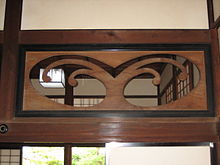Transom (architecture): Difference between revisions
Wikiuser100 (talk | contribs) Insufficiently germane |
fanlights are not shape irrespective |
||
| Line 1: | Line 1: | ||
[[Image:DoorEsplanadeDec071260.jpg|thumb|A transom and transom light over double doors]] |
[[Image:DoorEsplanadeDec071260.jpg|thumb|A transom and transom light over double doors]] |
||
In [[architecture]], a '''transom''' is the term given to a transverse horizontal structural beam or bar, or to the crosspiece separating a door or the like from a window above it, as opposed to a [[mullion]] which refers to a vertical structural member.<ref name="efficient">{{cite web |url=http://www.efficientwindows.org/glossary.cfm#t |title=The Efficient Windows Collaborative: Glossary |accessdate=2007-12-13}}</ref> Transom is also the customary [[American English|U.S.]] word used for a '''transom light''', the window over this crosspiece.<ref name="efficient"/><ref name=bigblue>{{cite web |url=http://www.bigbluewindow.com/faq.aspx#q50 |title=What is a transom window? |publisher=Big Blue Window |accessdate=2007-12-13}}</ref> In [[British English|Britain]], the 'transom light' above a door is usually referred to as a "[[fanlight]]" |
In [[architecture]], a '''transom''' is the term given to a transverse horizontal structural beam or bar, or to the crosspiece separating a door or the like from a window above it, as opposed to a [[mullion]] which refers to a vertical structural member.<ref name="efficient">{{cite web |url=http://www.efficientwindows.org/glossary.cfm#t |title=The Efficient Windows Collaborative: Glossary |accessdate=2007-12-13}}</ref> Transom is also the customary [[American English|U.S.]] word used for a '''transom light''', the window over this crosspiece.<ref name="efficient"/><ref name=bigblue>{{cite web |url=http://www.bigbluewindow.com/faq.aspx#q50 |title=What is a transom window? |publisher=Big Blue Window |accessdate=2007-12-13}}</ref> In [[British English|Britain]], the 'transom light' above a door is usually referred to as a "[[fanlight]]" if a semi-elliptical shape, and occasionally as an "overlight" or "hopper", or by the French word "vasistas".<ref name=euro>{{cite web |url=http://www.eurodict.koralsoft.com/VASISTAS+searchid-70270-ed_tr_en.html |title=Euro Dictionary: Vasistas |accessdate=2007-12-13}} {{Dead link|date=October 2010|bot=H3llBot}}</ref> |
||
==History== |
==History== |
||
Revision as of 18:46, 25 December 2012

In architecture, a transom is the term given to a transverse horizontal structural beam or bar, or to the crosspiece separating a door or the like from a window above it, as opposed to a mullion which refers to a vertical structural member.[1] Transom is also the customary U.S. word used for a transom light, the window over this crosspiece.[1][2] In Britain, the 'transom light' above a door is usually referred to as a "fanlight" if a semi-elliptical shape, and occasionally as an "overlight" or "hopper", or by the French word "vasistas".[3]
History
In early Gothic ecclesiastical work, transoms are found only in belfry unglazed windows or spire lights, where they were deemed necessary to strengthen the mullions in the absence of the iron stay bars, which in glazed windows served a similar purpose. In the later Gothic, and more especially the Perpendicular Period, the introduction of transoms became common in windows of all kinds.[4]
Transom windows which could be opened to provide cross-ventilation while maintaining security and privacy (due to their small size and height above floor level) were a common feature of office buildings and apartments before air conditioning became common.
Idiomatic usage
- The phrase over the transom refers to works submitted for publication without being solicited. The image evoked is of a writer tossing a manuscript through the open window over the door of the publisher's office.[5]
- Similarly, the phrase is used to describe the means by which confidential documents, information or tips were delivered anonymously to someone who is not officially supposed to have them.[6]
- "Like pushing a piano through a transom" is a folk idiom used to describe something exceedingly difficult; its application to childbirth (and possibly its origin) has been attributed to Alice Roosevelt Longworth and Fannie Brice.
Japan

Architectural details called ranma (欄間) are often found above doors in traditional Japanese houses and buildings. These details can be anything from simple shōji-style dividers to elaborate wooden carvings.
See also
![]() Media related to Transoms (architectural elements) at Wikimedia Commons
Media related to Transoms (architectural elements) at Wikimedia Commons
References
- ^ a b "The Efficient Windows Collaborative: Glossary". Retrieved 2007-12-13.
- ^ "What is a transom window?". Big Blue Window. Retrieved 2007-12-13.
- ^ "Euro Dictionary: Vasistas". Retrieved 2007-12-13. [dead link]
- ^ "The Principles of Gothic Ecclesiastical Architecture, Elucidated by Question and Answer, 4th ed". Project Gutenberg. Retrieved 2007-12-13.
- ^ "What Does Over The Transom Mean?". About Freelance Writing. Retrieved 2007-12-13.
- ^ Hartocollis, Anemona. Former G.O.P. Official Admits He Evaded Taxes, The New York Times, 16 November 2007. DA Morganthau Cites "Over the Transom" Letter as root of fraud investigation
